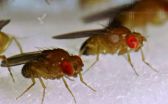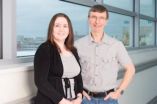(Press-News.org) CHICAGO – Solving crucial environmental issues such as global warming and water supply involves managing competing interests, uncertainty and risk, and this is best done through meaningful collaboration in a neutral environment.
Arizona State University Barrett Honors College Lecturer John N. Parker discussed the ways in which scientists, stakeholders and policy makers can communicate effectively by coming together through boundary organizations at the annual meeting of the American Association for the Advancement of Science in Chicago.
Boundary organizations are designed to facilitate collaboration and information-flow between the research and public policy communities by defining roles and working in mutually cohesive environments to cross hurdles in to order to address natural resource challenges.
Parker's talk, "On Being All Things to All People: Boundary Organizations and Scientists," was part of the AAAS "Decision-Making in the Public Domain: Boundary Processes as Catalysts for Innovation" symposium held on Feb. 17. The session featured researchers and non-academic representatives who work with scientists, policy makers and the public to devise environmental solutions.
Parker discussed how addressing pressing problems such as water availability, emerging energy technologies like fracking, and species decline and extinction requires integrating knowledge and perspectives from varied communities who come together and work for a positive solution through ad hoc working groups and boundary organizations that offer incentives and accountability in a politically neutral arena.
"The scale of the issues are critical at this time in history since the future of humans depends on the ability to manage complex problems that cross scales and involve many different groups who at times cooperate and at other times are in conflict with one another," Parker said.
Boundary processes link science to public policy and better inform environmental decisions through science. This process can be difficult when stakeholders and policy makers work under different reward systems, such as scientists striving for grants and conducting research that make take months compared to a policymaker or stakeholder who may need information immediately to answer to the public and constituents.
Democratic processes that involve scientists, policy makers, the public and ecosystem and resource system managers who come together in productive ways lead to the application of collective knowledge to address problems, he added.
Parker's research in this area was detailed in the article, "On being all things to all people: Boundary Organizations and the Contemporary Research University" that was published in the March 2012 edition of the Social Studies of Science journal with Beatrice Crona of the Stockholm Resilience Centre.
INFORMATION:
Contacts:
John Parker
John.Parker@asu.edu
Julie Newberg
ASU Media Relations
Julie.Newberg@asu.edu
(480) 727-3116
Environmental issues examined through cohesive efforts
Environmental issues examined in cohesive efforts through science, policymakers, stakeholders and the public
2014-02-18
ELSE PRESS RELEASES FROM THIS DATE:
NUS researchers make new discovery of protein as a promising target for treatment of ATC
2014-02-18
Anaplastic thyroid carcinoma (ATC) is an aggressive type of cancer with a poor prognosis for which there is currently no effective treatment. Researchers from the National University of Singapore (NUS) have discovered for the first time that an epithelial basement membrane protein, called laminin-5 gamma-2 (LAMC2), has the potential to be an ideal target for the treatment of ATC.
Led by Professor H. Phillip Koeffler, Senior Principal Investigator, and Dr Manoj Garg, Research Fellow, at the Cancer Science Institute of Singapore (CSI Singapore) at NUS, the team is also ...
KAIST developed low-powered, high-speed head-mounted display with augment reality chip
2014-02-18
Daejeon, Republic of Korea, February 17, 2014 – Walking around the streets searching for a place to eat will be no hassle when a head-mounted display (HMD) becomes affordable and ubiquitous. Researchers at the Korea Advanced Institute of Science and Technology (KAIST) developed K-Glass, a wearable, hands-free HMD that enables users to find restaurants while checking out their menus. If the user of K-Glass walks up to a restaurant and looks at the name of the restaurant, today's menu and a 3D image of food pop up. The Glass can even show the number of tables available inside ...
Gender and genes play an important role in delayed language development
2014-02-18
Boys are at greater risk for delayed language development than girls, according to a new study using data from the Norwegian Mother and Child Cohort Study. The researchers also found that reading and writing difficulties in the family gave an increased risk.
"We show for the first time that reading and writing difficulties in the family can be the main reason why a child has a speech delay that first begins between three to five years of age," says Eivind Ystrøm, senior researcher at the Norwegian Institute of Public Health.
Ystrøm was supervisor of Imac Maria Zambrana, ...
Researchers identify new way to control stone fruit disease
2014-02-18
Researchers at the University of Kent and East Malling Research have identified a new way of controlling a fungal disease that can have a devastating impact on the UK's valuable cherry and plum crops.
Brown rot disease – caused by the agent Monilinia laxa – attacks stone fruit as well as causing blossom wilt and twig canker. Traditionally, this has been controlled through the use of fungicide treatments, but in some cases these are now becoming ineffective.
Now researchers from the two organisations have identified a new strategy for controlling the disease, using biological ...
In search of lost genes
2014-02-18
How do new genes arise? Current research shows that so-called "orphan genes" may appear as if by magic as a result of mutations in segments of DNA that previously had no function. Orphan genes were first discovered in the fruit fly but are found in all organisms, including man. Strikingly, up to 30 per cent of the total number of genes in an organism may be orphans and these genes may rapidly acquire functions. Scientists from the Institute of Population Genetics of the University of Veterinary Medicine, Vienna (Vetmeduni) have now investigated the fate of orphan genes. ...
HIV drug used to reverse effects of virus that causes cervical cancer
2014-02-18
A commonly-used HIV drug has been shown to kill-off the human papilloma virus (HPV) that leads to cervical cancer in a world-first clinical trial led by The University of Manchester with Kenyatta National Hospital (KNH) in Nairobi.
Drs Ian and Lynne Hampson, from the University's Institute of Cancer Sciences and Dr Innocent Orora Maranga, Consultant in Obstetrics and Gynaecology at KNH in Nairobi examined Kenyan women diagnosed with HPV positive early stage cervical cancer who were treated with the antiviral HIV drug lopinavir in Kenya.
The study looked at 40 women ...
Leeds researchers build world's most powerful terahertz laser chip
2014-02-18
A paper in the Institution of Engineering and Technology's (IET) journal Electronics Letters reports that the Leeds team has exceeded a 1 Watt output power from a quantum cascade terahertz laser.
The new record more than doubles landmarks set by the Massachusetts Institute of Technology (MIT) and subsequently by a team from Vienna last year.
Terahertz waves, which lie in the part of the electromagnetic spectrum between infrared and microwaves, can penetrate materials that block visible light and have a wide range of possible uses including chemical analysis, security ...
The conditions for a society to become a democracy are analyzed
2014-02-18
This news release is available in Spanish. In view of the changes that have taken place in Europe,JuleGoikoetxea, a lecturer at the UPV/EHU's Faculty of Social Sciences and Communication, has been conducting research into "the conditions needed for a people to become a democracy or sustain its democratisation process over time."The study has been published in the specialised journal Nationalities Papers.
According to Goikoetxea, nation is not synonymous with demos: "The nation is the will, socially and historically articulated, that a group has in order to be a political ...
Researchers shed new light on the genetic history of the European beaver
2014-02-18
An international team of scientists has used detailed analysis of ancient and modern DNA to show that the distribution and lack of genetic diversity among modern European beavers is due largely to human hunting.
The research, which was led by University of York researcher Professor Michi Hofreiter, provides important new insights into the genetic history of the Eurasian beaver Castor fiber. Crucially, it shows the European beaver has been strongly affected by expanding human populations for many thousands of years.
The researchers say that centuries of hunting, rather ...
Surprising survey: Most small businesses remain silent rather than report employee theft
2014-02-18
In a recent survey of small businesses, a University of Cincinnati criminal justice researcher has found that only 16 percent of those that have experienced theft by employees actually reported that theft to the police.
That's even though 64 percent of the small businesses surveyed reported experiencing employee theft.
These are some of the findings in a survey of small businesses that examined the incidence of employee theft, how often it was reported, the types of goods taken by employees, the types of employees most likely to commit theft, and the reasons the business ...
LAST 30 PRESS RELEASES:
Making lighter work of calculating fluid and heat flow
Normalizing blood sugar can halve heart attack risk
Lowering blood sugar cuts heart attack risk in people with prediabetes
Study links genetic variants to risk of blinding eye disease in premature infants
Non-opioid ‘pain sponge’ therapy halts cartilage degeneration and relieves chronic pain
AI can pick up cultural values by mimicking how kids learn
China’s ecological redlines offer fast track to 30 x 30 global conservation goal
Invisible indoor threats: emerging household contaminants and their growing risks to human health
Adding antibody treatment to chemo boosts outcomes for children with rare cancer
Germline pathogenic variants among women without a history of breast cancer
Tanning beds triple melanoma risk, potentially causing broad DNA damage
Unique bond identified as key to viral infection speed
Indoor tanning makes youthful skin much older on a genetic level
Mouse model sheds new light on the causes and potential solutions to human GI problems linked to muscular dystrophy
The Journal of Nuclear Medicine ahead-of-print tip sheet: December 12, 2025
Smarter tools for peering into the microscopic world
Applications open for funding to conduct research in the Kinsey Institute archives
Global measure underestimates the severity of food insecurity
Child survivors of critical illness are missing out on timely follow up care
Risk-based vs annual breast cancer screening / the WISDOM randomized clinical trial
University of Toronto launches Electric Vehicle Innovation Ontario to accelerate advanced EV technologies and build Canada’s innovation advantage
Early relapse predicts poor outcomes in aggressive blood cancer
American College of Lifestyle Medicine applauds two CMS models aligned with lifestyle medicine practice and reimbursement
Clinical trial finds cannabis use not a barrier to quitting nicotine vaping
Supplemental nutrition assistance program policies and food insecurity
Switching immune cells to “night mode” could limit damage after a heart attack, study suggests
URI-based Global RIghts Project report spotlights continued troubling trends in worldwide inhumane treatment
Neutrophils are less aggressive at night, explaining why nighttime heart attacks cause less damage than daytime events
Menopausal hormone therapy may not pose breast cancer risk for women with BRCA mutations
Mobile health tool may improve quality of life for adolescent and young adult breast cancer survivors
[Press-News.org] Environmental issues examined through cohesive effortsEnvironmental issues examined in cohesive efforts through science, policymakers, stakeholders and the public




